Bikepacking in Botswana: Bobonong to Palapye via Robelela
#1
Original Poster
Join Date: May 2022
Posts: 26
Likes: 0
Received 0 Likes
on
0 Posts
Bikepacking in Botswana: Bobonong to Palapye via Robelela
Botswana is renowned for scorching sun, deep sand and large, dangerous animals. On the face of it, not an ideal destination for bikepacking. But when we came to Botswana to live our bikes came along, and there are plenty of places to use them. November is a very quiet time of the year here, so our company shut up shop for a few days last week and went exploring on our bikes. It was 285 km of gravel trail which takes you through some wild country far from the usual tourist spots. We did it over four days. Itís a great way to see the country and meet the people.
November isnít really the best time of year for a cycling trip here. It tends to be hot. The forecast clouds and light rain didnít appear, and instead we were cycling through a heatwave. The backpacks were quickly dumped into the support vehicle, and in the heat of the day the helmets were put on over sunhats.
Day 1: 30 km in the saddle.
Bobonong always seems exotic. A market village with stalls selling everything imaginable clustered around the bus rank; donkey carts mingling with the traffic, and flocks of goats wandering freely and unattended through the streets. For me it has always been the edge of adventure: a gateway to the wild country beyond, and a last chance to stock up on essentials. There is even a shop that sells some bicycle parts. Nothing esoteric, but if youíve forgotten to bring chain oil they will have some.
And the street food is delicious. The local tribe are BaBirwa, and their cuisine is very different to that of the Tswana. One favourite is delele, a kind of wild jute which has a lovely flavour but a rather unusual texture, producing long gooey strings from fork to plate. Messy to eat but well worthwhile. But we canít linger.
Surprised children shout Lekgoa mo baesekeleng (a white man on a bicycle) as we ride to the edge of the village. Tourists are rare in Bobonong, and bikepackers are a real novelty. It would be fun to stop and chat, but we want to reach the Lepokole Hills before dark. Should have set out earlier !
We turn off the tarred road 5 km beyond the village, and from here on itís gravel all the way. The ploughing fields with their neatly thatched mud huts give way to forest as we leave the river floodplain and gently climb into the hills and through a rocky pass. The forest here is full of baboons, vervet monkeys and brightly coloured birds, but the road demands close attention as here and there boulders peep through the gravel surface. Itís hard to maintain a regular rhythm.
Tonightís accommodation is the Lepokole Hills Nature Reserve, which lies beyond the pass. This reserve is run by the local community. They have a camping site with fixed tents and bedding. The reserve is fenced to keep the elephants out Ė the big attraction here is the San (Kalahari Bushman) rock art, and no-one wants the elephants to damage it. The other attraction is climbing the big granite domes. From the top of the domes you can see for miles.
You wonít find a coffee machine in Lepokole village but you will find ladies brewing traditional beverages, and a litre of sorghum beer or brandybush wine is a very affordable BWP 7 Ė about 60c US..
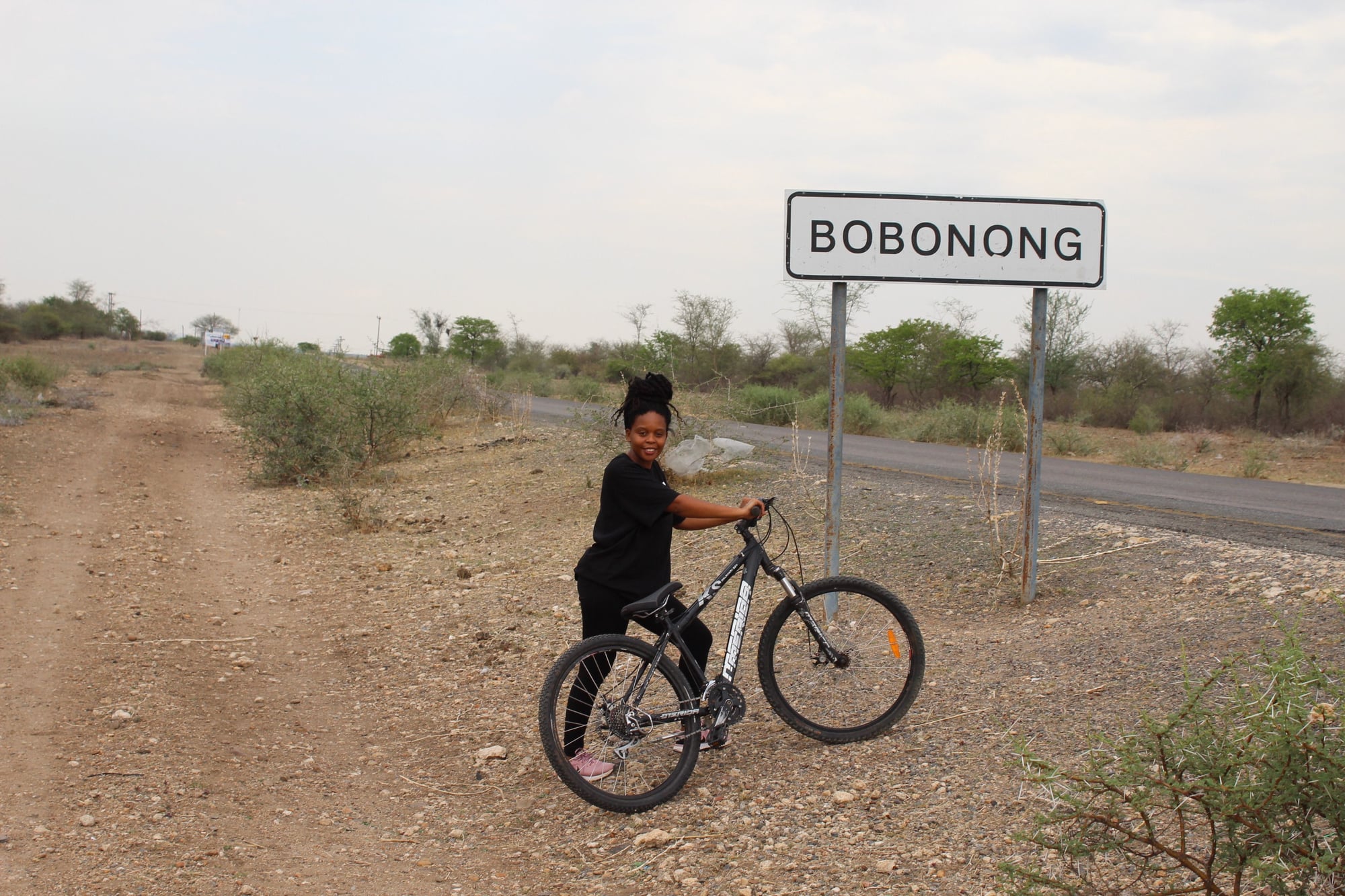
We actually started our trip in the middle of Bobonong. But Naomi wanted to pose with the road sign ! The main roads in Botswana often have a gravel track like this running alongside, mainly used by donkey carts but handy for cyclists !
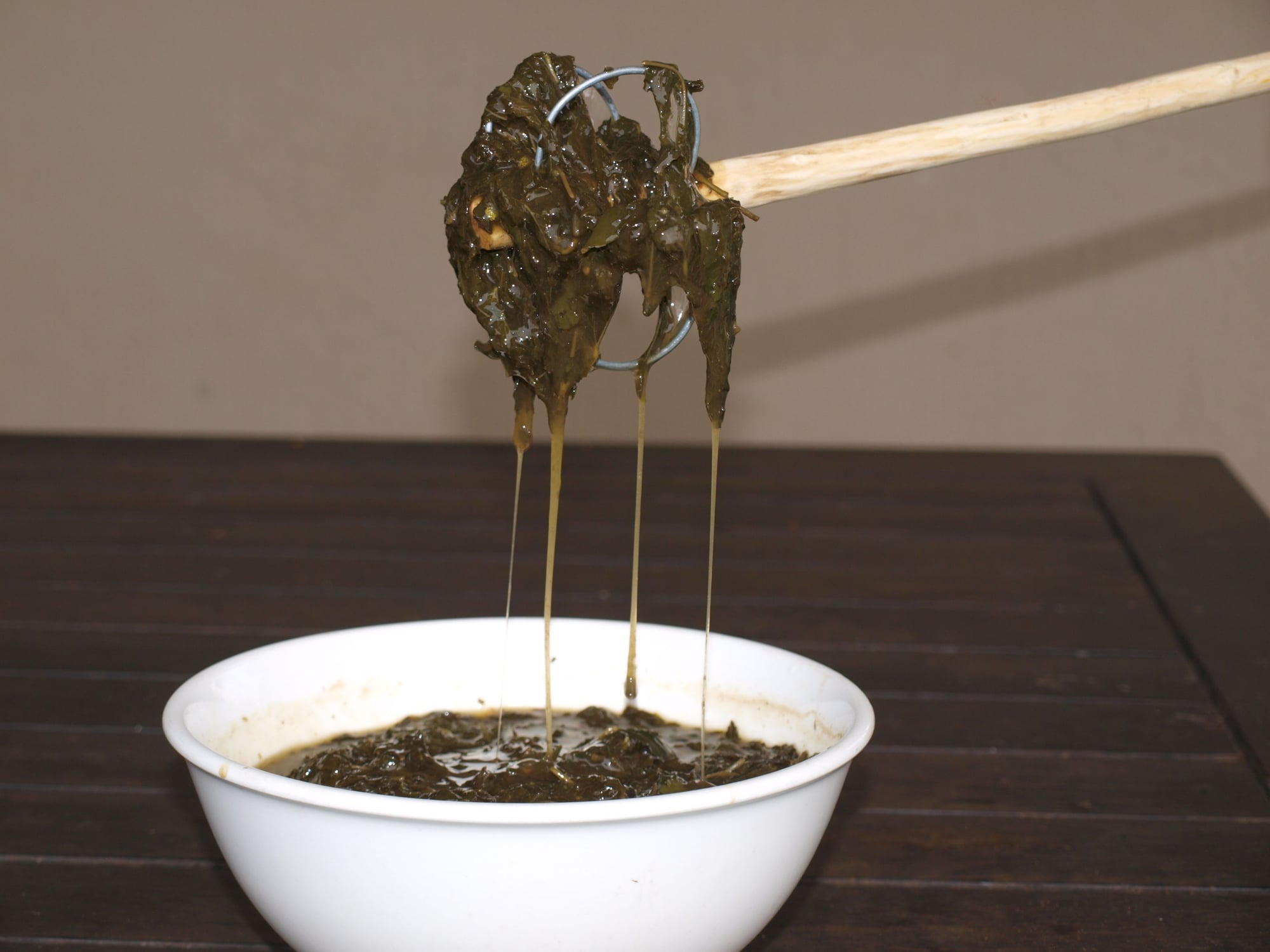
Gooey strings from a plate of delele. Messy to eat but delicious.
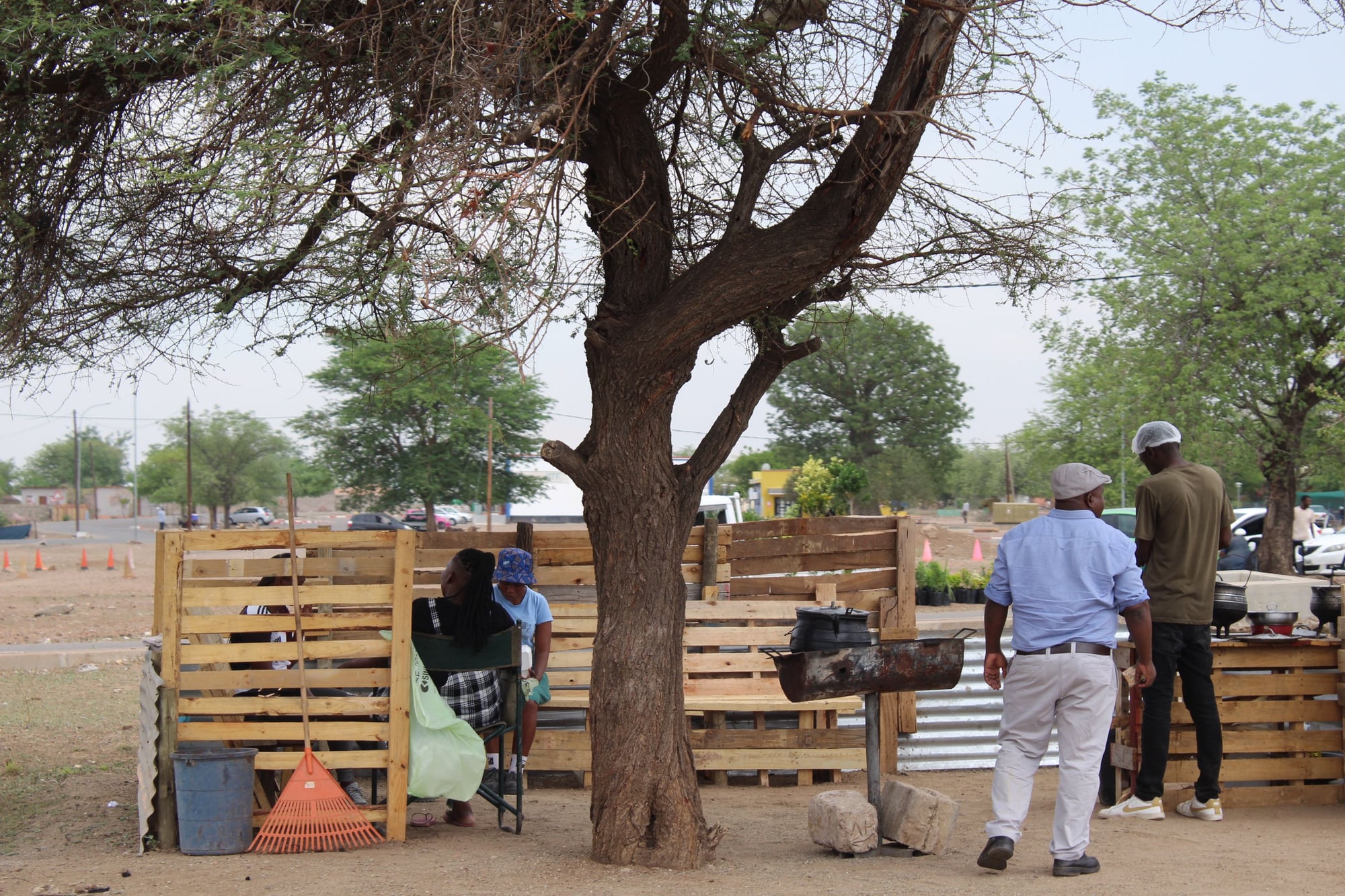
A street kitchen in Bobonong
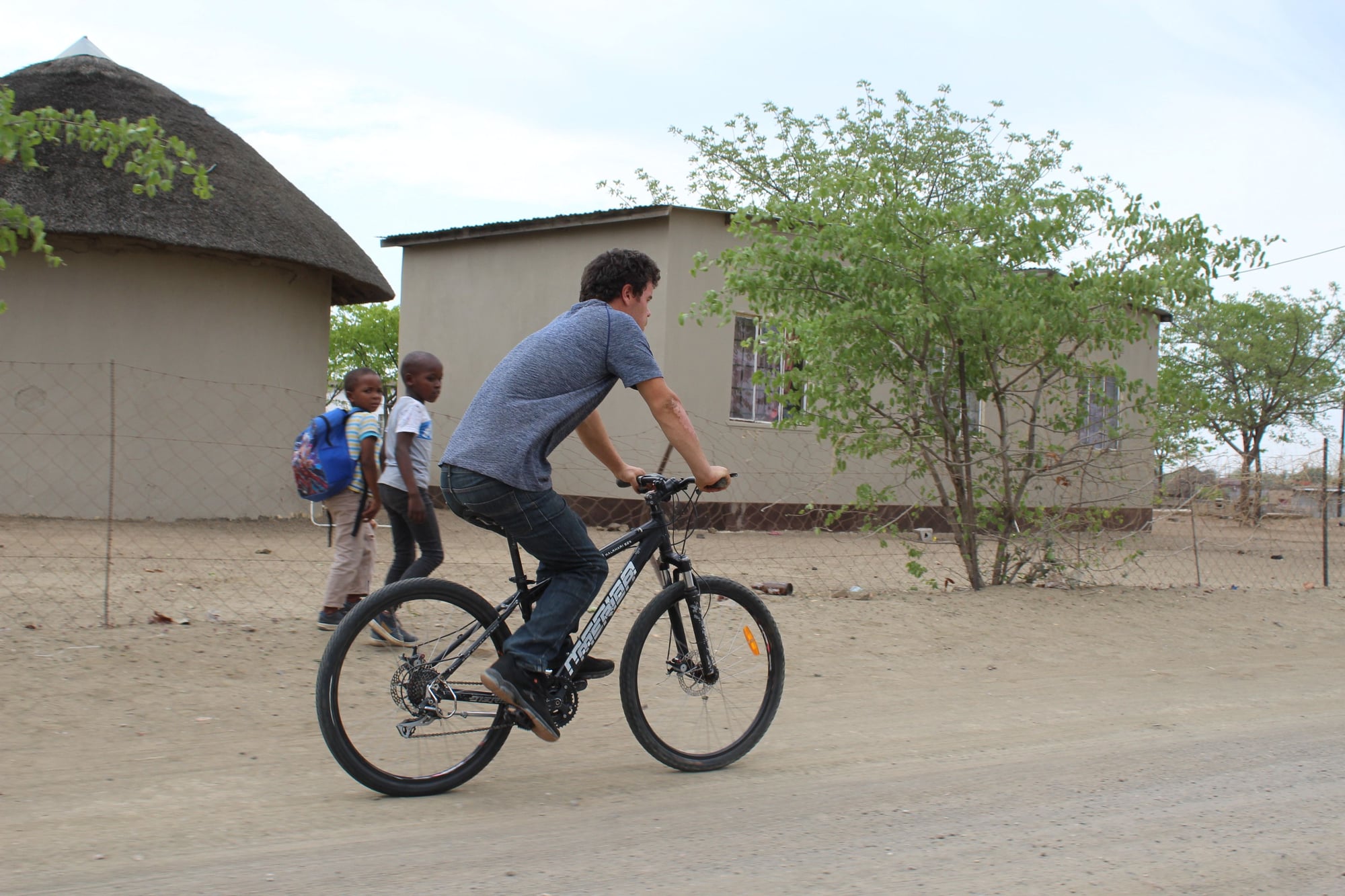
Lekgoa mo baesekeleng ! James roadtesting an adjustment before we set out in earnest.
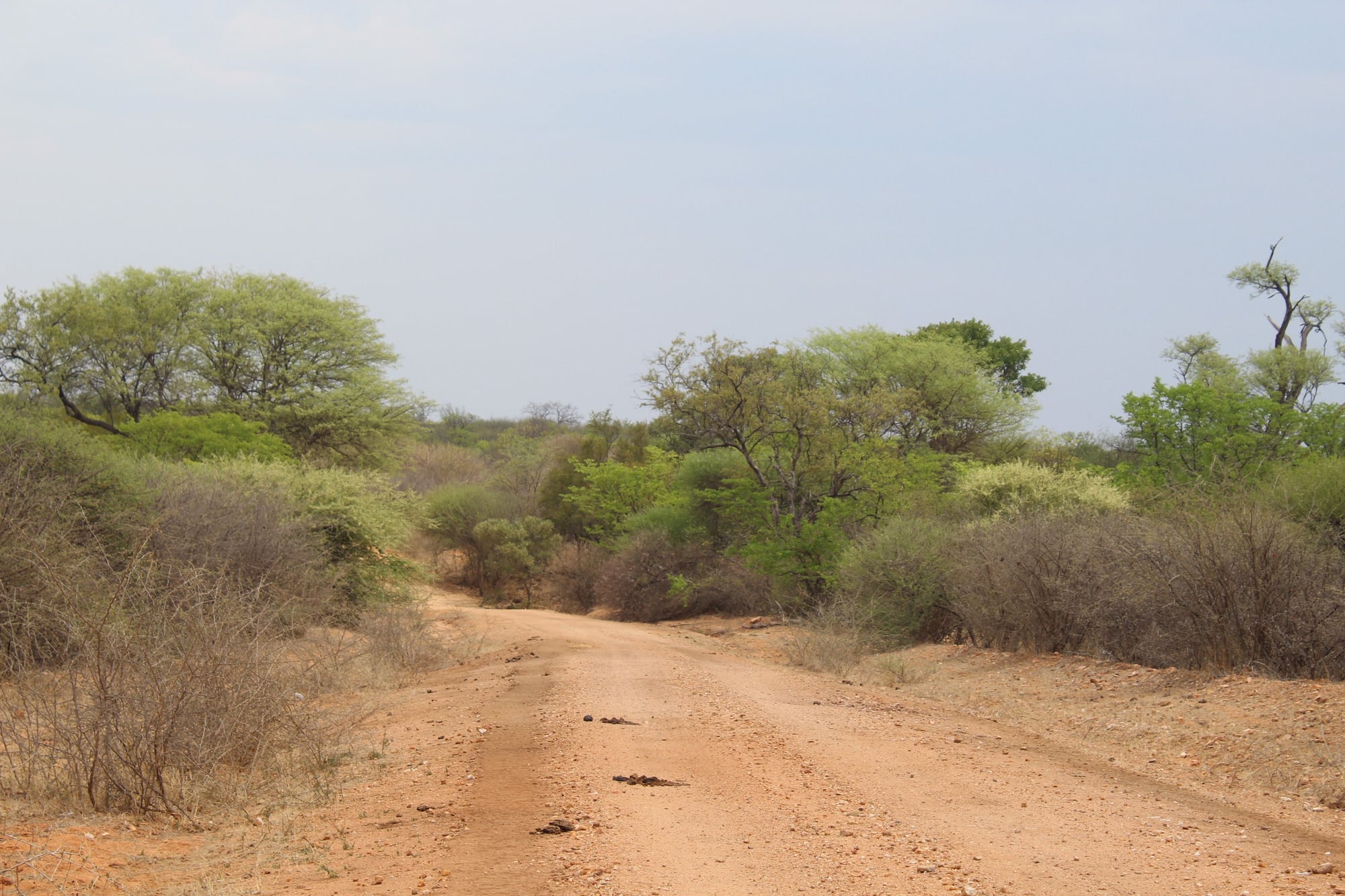
Deserted gravel roads and easy pedaling: a cyclist's heaven.

The Lepokole Hills
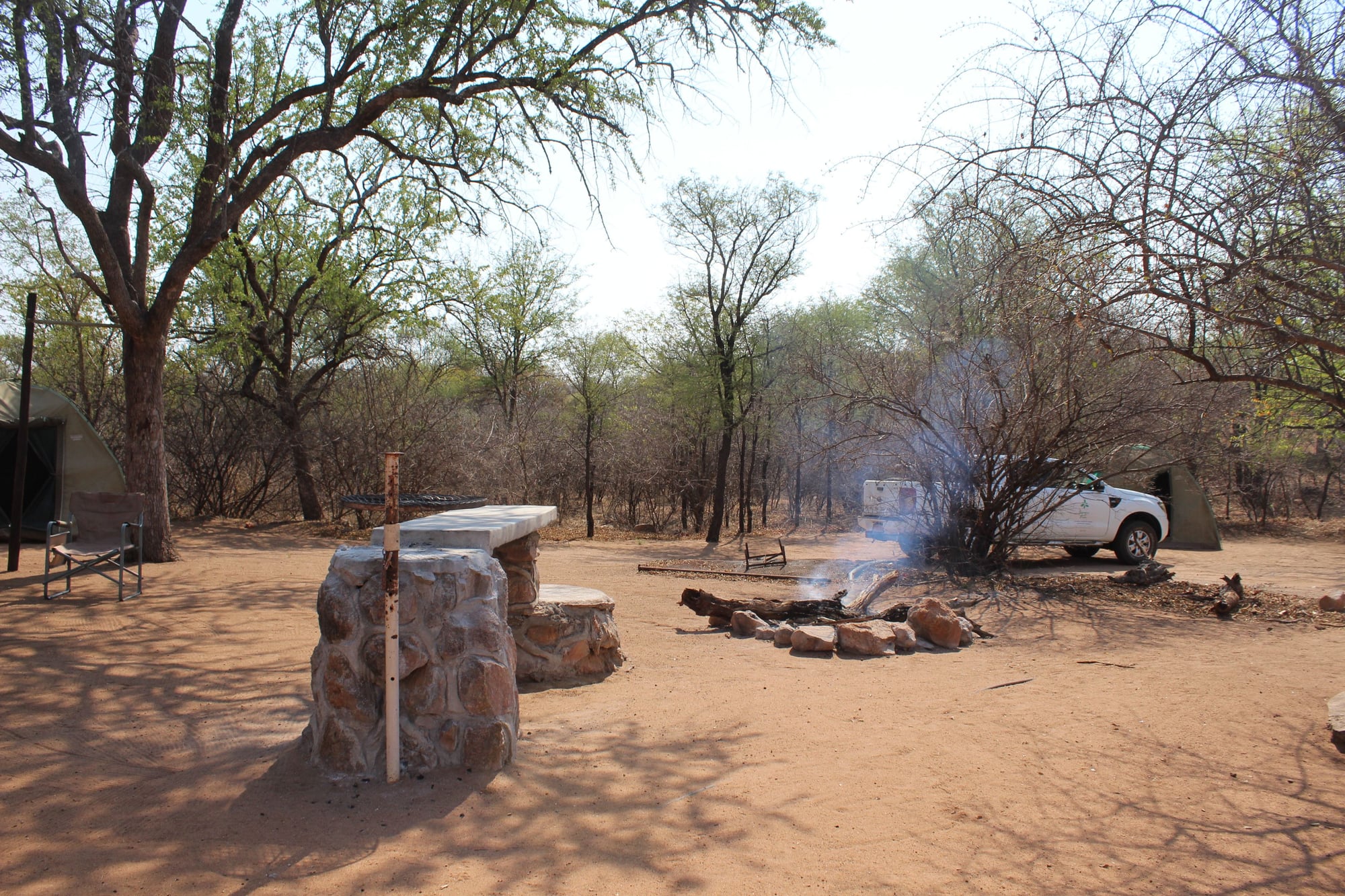
Lepokole Hills campsite
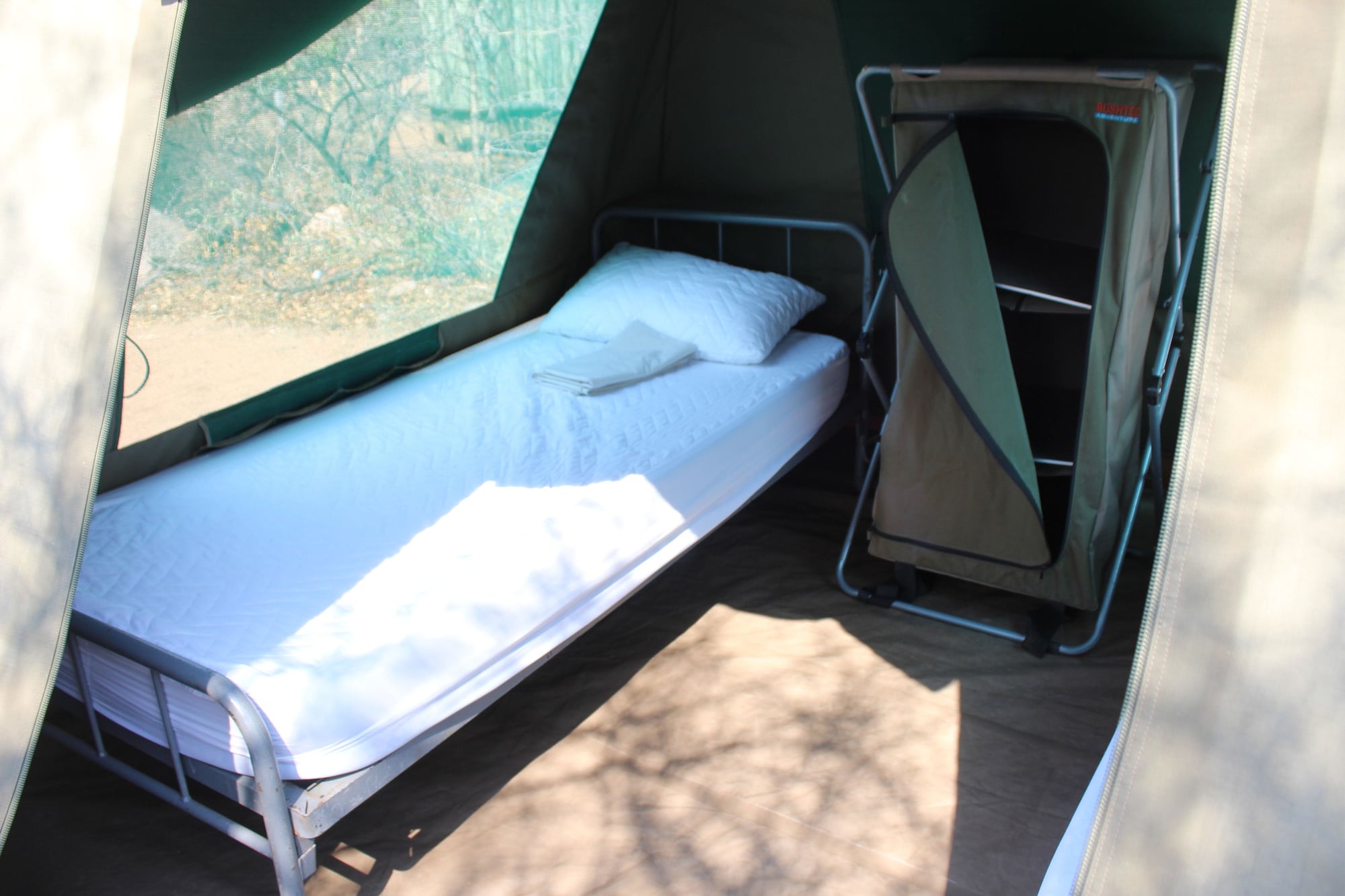
A welcome bed - a private furnished tent for about USD 12 for the night
November isnít really the best time of year for a cycling trip here. It tends to be hot. The forecast clouds and light rain didnít appear, and instead we were cycling through a heatwave. The backpacks were quickly dumped into the support vehicle, and in the heat of the day the helmets were put on over sunhats.
Day 1: 30 km in the saddle.
Bobonong always seems exotic. A market village with stalls selling everything imaginable clustered around the bus rank; donkey carts mingling with the traffic, and flocks of goats wandering freely and unattended through the streets. For me it has always been the edge of adventure: a gateway to the wild country beyond, and a last chance to stock up on essentials. There is even a shop that sells some bicycle parts. Nothing esoteric, but if youíve forgotten to bring chain oil they will have some.
And the street food is delicious. The local tribe are BaBirwa, and their cuisine is very different to that of the Tswana. One favourite is delele, a kind of wild jute which has a lovely flavour but a rather unusual texture, producing long gooey strings from fork to plate. Messy to eat but well worthwhile. But we canít linger.
Surprised children shout Lekgoa mo baesekeleng (a white man on a bicycle) as we ride to the edge of the village. Tourists are rare in Bobonong, and bikepackers are a real novelty. It would be fun to stop and chat, but we want to reach the Lepokole Hills before dark. Should have set out earlier !
We turn off the tarred road 5 km beyond the village, and from here on itís gravel all the way. The ploughing fields with their neatly thatched mud huts give way to forest as we leave the river floodplain and gently climb into the hills and through a rocky pass. The forest here is full of baboons, vervet monkeys and brightly coloured birds, but the road demands close attention as here and there boulders peep through the gravel surface. Itís hard to maintain a regular rhythm.
Tonightís accommodation is the Lepokole Hills Nature Reserve, which lies beyond the pass. This reserve is run by the local community. They have a camping site with fixed tents and bedding. The reserve is fenced to keep the elephants out Ė the big attraction here is the San (Kalahari Bushman) rock art, and no-one wants the elephants to damage it. The other attraction is climbing the big granite domes. From the top of the domes you can see for miles.
You wonít find a coffee machine in Lepokole village but you will find ladies brewing traditional beverages, and a litre of sorghum beer or brandybush wine is a very affordable BWP 7 Ė about 60c US..

We actually started our trip in the middle of Bobonong. But Naomi wanted to pose with the road sign ! The main roads in Botswana often have a gravel track like this running alongside, mainly used by donkey carts but handy for cyclists !

Gooey strings from a plate of delele. Messy to eat but delicious.

A street kitchen in Bobonong

Lekgoa mo baesekeleng ! James roadtesting an adjustment before we set out in earnest.

Deserted gravel roads and easy pedaling: a cyclist's heaven.

The Lepokole Hills

Lepokole Hills campsite

A welcome bed - a private furnished tent for about USD 12 for the night
#2
Original Poster
Join Date: May 2022
Posts: 26
Likes: 0
Received 0 Likes
on
0 Posts
Day 2: Lepokole to Robelela: 48 km of pedaling
Day 2: 48 km in the saddle
The gravel road from Lepokole to Robelela is little used by cars. It initially runs through cattlepost country, and the sparse local traffic is mainly donkey carts. The first half cuts across the grain of the countryside, crossing numerous small rivers. Each is an invitation to stop beneath a shady tree and sit for a few minutes to see what wildlife is about. Most of the mammals in these parts are nocturnal, but mongoose and monkeys are diurnal and always fun to watch; with luck there will be big monitor lizards; and there will always be birds.
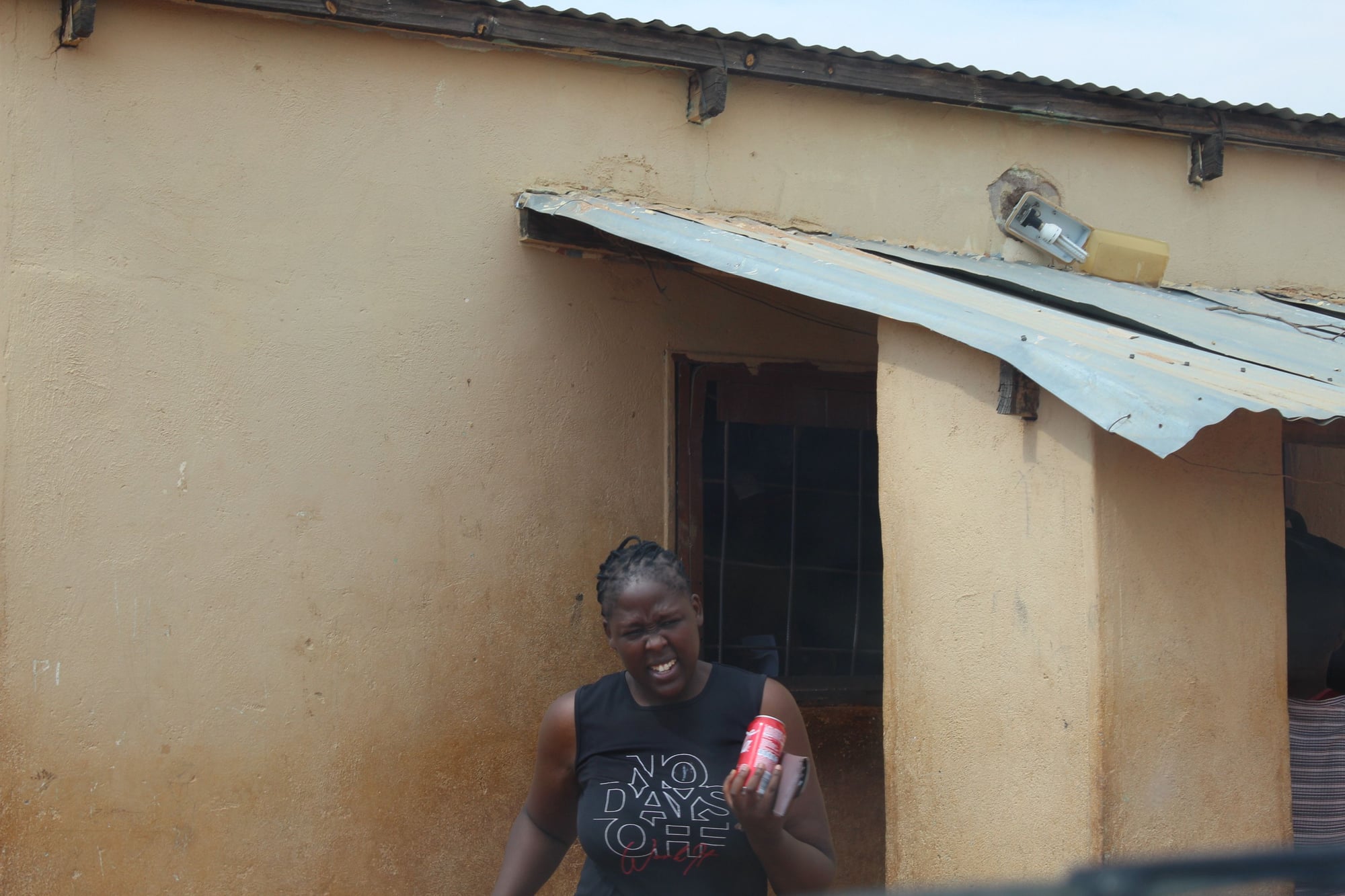
The tiny shop in Tshokwe doesn't sell much, but icy cold drinks are always welcome. Peo got the last can.
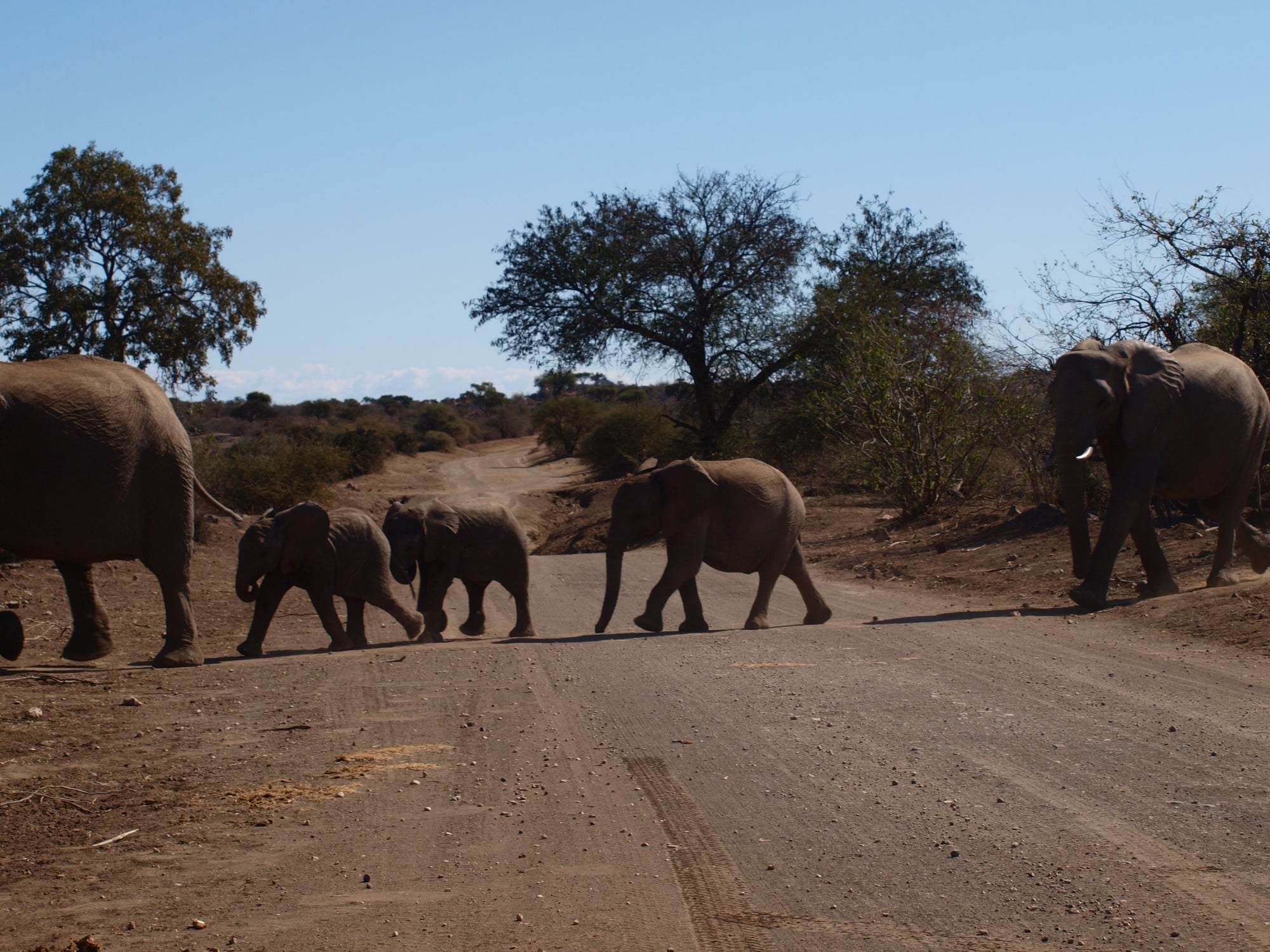
They get automatic right-of-way !
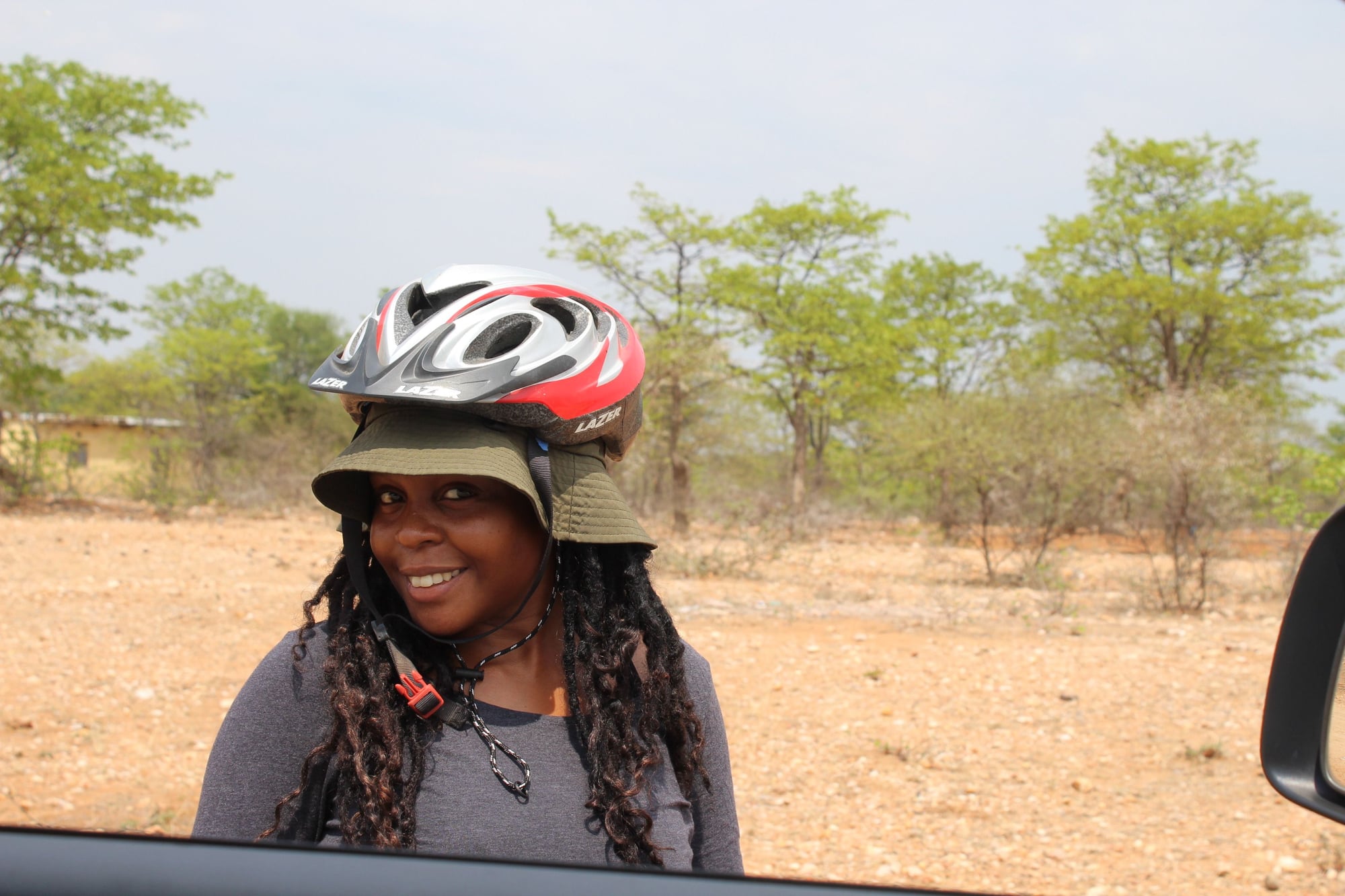
Sun hat or helmet ? Naomi found a way to wear both at once
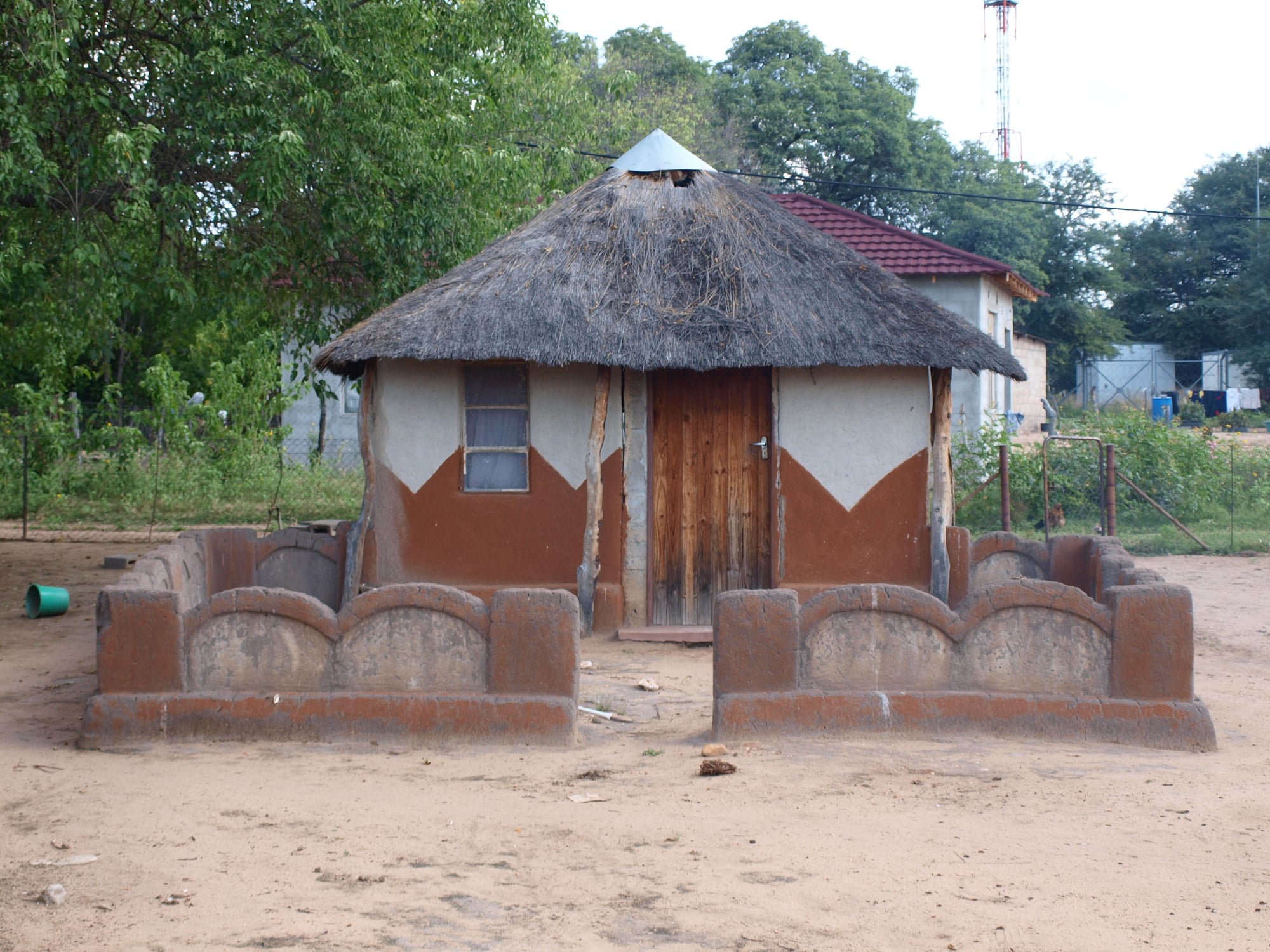
The exterior plaster of a hut is a mixture of sand, clay and cow dung. Different coloured sands are used to create the patterns.
Local families will have their main house in a village; a picturesque thatched hut in their ploughing field, to be occupied seasonally; and another, typically less picturesque hut at their cattlepost. The cattle roam freely on common land during the day, but are locked up in a kraal at night to keep them away from leopards, and one of the menfolk will stay with them.
Every Motswana seems to be happiest at his cattlepost. Cattle are an important part of the national psyche. The man you see dressed in rags, herding his cattle of a weekend may be a city lawyer in a smart suit during the week. There might be a BMW tucked away behind the hut. Or he might be an economic refugee from Zimbabwe, fleeing destitution back home. Here at the cattlepost both will be the envy of their peers.
Just after lunch we were at the little village of Tshokwe, population 1586 at the last census. Tswana tradition is to set an extra place at the table in case a stranger should show up This custom has died out in the cities, but is alive and well in the countryside. It would be rude to refuse an invitation into a family compound. Rural Tswana dishes look simple at first glance, but what they have to offer is so much more than meets the eye. Lehata is a lovely stew of mung beans and fresh sorghum kernels. Mophane stew is dried and salted caterpillars stewed with tomato, capsicum, onion, fresh chilli, cumin and minced garlic. Absolutely delicious.
The 23 km from Tshokwe to Robelela is through forest much of the way: easy pedaling but you have to keep your eyes fixed on the road. This is elephant country, and the piles of elephant dung left on the road are a very real hazard to an unwary cyclist.
What to do if you meet an elephant ? If you donít bother them they wonít bother you. But cycling between a mother and her calf is best avoided. The elephants typically travel in herds, and if the herd is feeding on both sides of the road it might be better to stop and wait for them to move off.
Robelela is a tiny, backblocks village and unless you have brought your own tent there is nowhere to stay. We had the luxury of a support vehicle, and at 39 degrees C camping seemed less attractive. So we opted for a night of air conditioned comfort at Phokoje Bush Lodge, 50 km away. It has an extensive menu. New Zealand greenshell mussels in a creamy white wine sauce are hard to resist, and so is the swimming pool. Just the thing for an overheated cyclist !
The gravel road from Lepokole to Robelela is little used by cars. It initially runs through cattlepost country, and the sparse local traffic is mainly donkey carts. The first half cuts across the grain of the countryside, crossing numerous small rivers. Each is an invitation to stop beneath a shady tree and sit for a few minutes to see what wildlife is about. Most of the mammals in these parts are nocturnal, but mongoose and monkeys are diurnal and always fun to watch; with luck there will be big monitor lizards; and there will always be birds.

The tiny shop in Tshokwe doesn't sell much, but icy cold drinks are always welcome. Peo got the last can.

They get automatic right-of-way !

Sun hat or helmet ? Naomi found a way to wear both at once

The exterior plaster of a hut is a mixture of sand, clay and cow dung. Different coloured sands are used to create the patterns.
Local families will have their main house in a village; a picturesque thatched hut in their ploughing field, to be occupied seasonally; and another, typically less picturesque hut at their cattlepost. The cattle roam freely on common land during the day, but are locked up in a kraal at night to keep them away from leopards, and one of the menfolk will stay with them.
Every Motswana seems to be happiest at his cattlepost. Cattle are an important part of the national psyche. The man you see dressed in rags, herding his cattle of a weekend may be a city lawyer in a smart suit during the week. There might be a BMW tucked away behind the hut. Or he might be an economic refugee from Zimbabwe, fleeing destitution back home. Here at the cattlepost both will be the envy of their peers.
Just after lunch we were at the little village of Tshokwe, population 1586 at the last census. Tswana tradition is to set an extra place at the table in case a stranger should show up This custom has died out in the cities, but is alive and well in the countryside. It would be rude to refuse an invitation into a family compound. Rural Tswana dishes look simple at first glance, but what they have to offer is so much more than meets the eye. Lehata is a lovely stew of mung beans and fresh sorghum kernels. Mophane stew is dried and salted caterpillars stewed with tomato, capsicum, onion, fresh chilli, cumin and minced garlic. Absolutely delicious.
The 23 km from Tshokwe to Robelela is through forest much of the way: easy pedaling but you have to keep your eyes fixed on the road. This is elephant country, and the piles of elephant dung left on the road are a very real hazard to an unwary cyclist.
What to do if you meet an elephant ? If you donít bother them they wonít bother you. But cycling between a mother and her calf is best avoided. The elephants typically travel in herds, and if the herd is feeding on both sides of the road it might be better to stop and wait for them to move off.
Robelela is a tiny, backblocks village and unless you have brought your own tent there is nowhere to stay. We had the luxury of a support vehicle, and at 39 degrees C camping seemed less attractive. So we opted for a night of air conditioned comfort at Phokoje Bush Lodge, 50 km away. It has an extensive menu. New Zealand greenshell mussels in a creamy white wine sauce are hard to resist, and so is the swimming pool. Just the thing for an overheated cyclist !
#5
Original Poster
Join Date: May 2022
Posts: 26
Likes: 0
Received 0 Likes
on
0 Posts
Day 3: Robelela to Mmadinare
Sorry about the long delay folks ! My laptop died suddenly and took my Fodors logon credentials with it. I've just found my hard copy of the credentials behind my filing cabinet, so now I can finish the story for anybody still interested....Day 3: Robelela to Mmadinare 58 km
This morning itís back to the trail. The giant Dikgatlhong Dam at Robelela is at the top end of the North South Connector pipeline. Most of the population of Botswana is in the south, whilst most of the water is in the north. The pipeline is the biggest engineering project ever undertaken in the country, built to prevent Gaborone from running out of water. From Robelela to Palapye you can follow the all-weather pipeline service road. Unless work is being done on the pipeline at the time the road will be deserted all the way, and it is packed gravel.
First stop is Robelela kayak port. The fishermen from Robelela ply their trade in canoes, each registered as a commercial fishing vessel with the government. Fresh fish pan-fried over a campfire is really hard to beat.
Then on through the hills and forest to Mmadinare. This is lion country.
I have mixed feelings about lions. Iím pleased they are there, but I donít really want to see one. Not from a bike, anyway. Like dogs, they are said to chase cyclists for fun. Especially those wearing bright colours. Even Harrie Lavreysen couldnít outpace a lion over a short course, and Iím not in his league. This time all we saw were kudu, impala, duiker and steenbok. Lions are rare, and donít really see humans as prey. But we didnít tempt fate, leaving the fluorescent lycra at home.
Nearing Mmadinare is the big Letsibogo Dam. Itís used for town water supply, so swimming is discouraged. Why I donít know, since elephants, baboons and livestock have free access and the water is treated very thoroughly before it reaches domestic taps. The dam is also the training ground for the Botswana yachting team. It was a rude shock when they entered their first ocean regatta in Capetown: they were very skilled in avoiding rocks, dead trees and other obstacles, but had never seen an ocean swell and came last. But even if you canít swim the Letsibogo Dam is a great place for a picnic.
Mmadinare is a sizeable village with a population of 13,200. There are campgrounds, guesthouses, a fishing lodge and of course the yacht club. Amenities like an ATM, a supermarket and icecreams. And more small children shouting Lekgoa mo baesekeleng.
When after authentic street food itís hard to go past Mapakong Corner Restaurant. They serve thepe Ė a kind of wild amaranth much appreciated in this part of the world. They also serve popular local dishes made of chicken intestines and cowís hooves. Try them if you dare !

Cycling along the shore of Dikatlhong Dam

A fisherman setting out early in the morning

Letsibogo Dam near Mmadinare

Mapakong Kitchen
.
This morning itís back to the trail. The giant Dikgatlhong Dam at Robelela is at the top end of the North South Connector pipeline. Most of the population of Botswana is in the south, whilst most of the water is in the north. The pipeline is the biggest engineering project ever undertaken in the country, built to prevent Gaborone from running out of water. From Robelela to Palapye you can follow the all-weather pipeline service road. Unless work is being done on the pipeline at the time the road will be deserted all the way, and it is packed gravel.
First stop is Robelela kayak port. The fishermen from Robelela ply their trade in canoes, each registered as a commercial fishing vessel with the government. Fresh fish pan-fried over a campfire is really hard to beat.
Then on through the hills and forest to Mmadinare. This is lion country.
I have mixed feelings about lions. Iím pleased they are there, but I donít really want to see one. Not from a bike, anyway. Like dogs, they are said to chase cyclists for fun. Especially those wearing bright colours. Even Harrie Lavreysen couldnít outpace a lion over a short course, and Iím not in his league. This time all we saw were kudu, impala, duiker and steenbok. Lions are rare, and donít really see humans as prey. But we didnít tempt fate, leaving the fluorescent lycra at home.
Nearing Mmadinare is the big Letsibogo Dam. Itís used for town water supply, so swimming is discouraged. Why I donít know, since elephants, baboons and livestock have free access and the water is treated very thoroughly before it reaches domestic taps. The dam is also the training ground for the Botswana yachting team. It was a rude shock when they entered their first ocean regatta in Capetown: they were very skilled in avoiding rocks, dead trees and other obstacles, but had never seen an ocean swell and came last. But even if you canít swim the Letsibogo Dam is a great place for a picnic.
Mmadinare is a sizeable village with a population of 13,200. There are campgrounds, guesthouses, a fishing lodge and of course the yacht club. Amenities like an ATM, a supermarket and icecreams. And more small children shouting Lekgoa mo baesekeleng.
When after authentic street food itís hard to go past Mapakong Corner Restaurant. They serve thepe Ė a kind of wild amaranth much appreciated in this part of the world. They also serve popular local dishes made of chicken intestines and cowís hooves. Try them if you dare !

Cycling along the shore of Dikatlhong Dam

A fisherman setting out early in the morning

Letsibogo Dam near Mmadinare

Mapakong Kitchen
.
#7
Original Poster
Join Date: May 2022
Posts: 26
Likes: 0
Received 0 Likes
on
0 Posts
Bikepacking Bobonong to Palapye- the final day
Beyond Mmadinare the pipeline road is very easy pedalling and you can settle into a groove. The forest glides by smoothly. It pays to start early, both to cover some distance in the cool of the morning, and also to catch the animal night shift before they head off to sleep. A bicycle lets you get close to wildlife in a way that a car does not, and we were rewarded with sightings of chanting goshawk, an eagle owl late in heading off to bed, a slender mongoose running across the trail, and a small spotted genet peeping out from a pile of rocks. The animal day shift was just zebra, impala, steenbok and vultures. There are Cape vultures breeding in the Tswapong Hills and they are a common sight as you get closer to Palapye.
The pipeline road winds its way through some little rocky hills. It's worth climbing one both for the view, and for a handful of wild figs, assuming of course that the baboons have left you some. These rock figs have the most wonderful flavour - better than any of the cultivated species
There is a veterinary cordon along the way. Botswana is divided into a jigsaw of disease control zones by long, double fences. If there is an outbreak of (say) foot & mouth disease the gates through these fences are closed to prevent animal movements. The Veterinary Department then gets on with disease control efforts in the affected zone. A necessary precaution since some of the neighbouring countries are rather careless about biosecurity.
Passing through the cordons during a disease outbreak can be something of a mission as bikes and shoes need to be sterilised. A search is also made for any animal products you might be carrying. But if there are no disease issues the gate will be opened and you are waved on your way.. And that is how it was for us.
Mid afternoon you come to a dam where you are allowed to swim Ė Bonwakathako - and from here it is an easy ride to Palapye itself.. We were heading for Segaigai Farm. It has a campsite, a luxurious self catering cottage, and quite a collection of tame nocturnal wildlife. There was a feast waiting for us, and I had some tame crested porcupines that wanted to help me with my dinner !
The farm is easily accessed from the Palapye end of the pipeline service road, and it is the starting point for the OPM hiking trail into the Tswapong Hills. But hiking the Tswapong trails is another story, and one that doesnít involve bikes. For us Segaigai Farm was the end of the journey.
The bikes
Iíve been riding one of the original Rocky Mountain Sherpa bikepacking bikes for years. This was the first bikepacking bike ever produced in Canada Ė the date stamped into my derailleur is 1981. Rocky Mountain have recycled the Sherpa name recently and applied it to a very fancy and expensive mountain bike, but I don't need to upgrade just yet. Peo and Leutlwetse rode Apollo Boardwalks, and James and Naomi took turns riding a Merida Kalahari s24 and driving the support vehicle. So there was nothing special about the bikes Ė any mountain bike will do. But thatís not true of the tyres. The flora of Botswana is dominated by trees with big thorns, and we all used the local Ďthornproofí tubeless tyres. There are bicycle shops in both Gaborone and Palapye that will fit these whilst you wait if you canít get them at home.
For navigation we used ĎTracks4Africaí downloadable maps on a tablet, but for this trip the route finding was straightforward and we could have managed without.
The logistics
You can reach both Palapye and Bobonong easily by public transport. 13 seater Ďcombií vans leave Gaborone and Francistown when full, and those towing luggage trailers will always have room for bikes on the trailer roof.
We did our trip with a support vehicle. The route takes you through some really remote countryside, and if you break a bike you are a long way from help. You can easily hire an unequipped 4x4 vehicle from Avis, Hertz, or Britz from the airport in Gaborone.
There are parts of Botswana with deep sand; and there are times of the year when it is scorching hot. But you can easily avoid both and have a great bikepacking trip.

A real zebra crossing

The pipeline service road

Rock fig trees - delicious fruits if you beat the baboons to them

Bonwakathako Dam. The Tswapong Hills and the end of the ride are in the distance

Dinner at Segaigai Farm

African Crested Porcupines are big !
The pipeline road winds its way through some little rocky hills. It's worth climbing one both for the view, and for a handful of wild figs, assuming of course that the baboons have left you some. These rock figs have the most wonderful flavour - better than any of the cultivated species
There is a veterinary cordon along the way. Botswana is divided into a jigsaw of disease control zones by long, double fences. If there is an outbreak of (say) foot & mouth disease the gates through these fences are closed to prevent animal movements. The Veterinary Department then gets on with disease control efforts in the affected zone. A necessary precaution since some of the neighbouring countries are rather careless about biosecurity.
Passing through the cordons during a disease outbreak can be something of a mission as bikes and shoes need to be sterilised. A search is also made for any animal products you might be carrying. But if there are no disease issues the gate will be opened and you are waved on your way.. And that is how it was for us.
Mid afternoon you come to a dam where you are allowed to swim Ė Bonwakathako - and from here it is an easy ride to Palapye itself.. We were heading for Segaigai Farm. It has a campsite, a luxurious self catering cottage, and quite a collection of tame nocturnal wildlife. There was a feast waiting for us, and I had some tame crested porcupines that wanted to help me with my dinner !
The farm is easily accessed from the Palapye end of the pipeline service road, and it is the starting point for the OPM hiking trail into the Tswapong Hills. But hiking the Tswapong trails is another story, and one that doesnít involve bikes. For us Segaigai Farm was the end of the journey.
The bikes
Iíve been riding one of the original Rocky Mountain Sherpa bikepacking bikes for years. This was the first bikepacking bike ever produced in Canada Ė the date stamped into my derailleur is 1981. Rocky Mountain have recycled the Sherpa name recently and applied it to a very fancy and expensive mountain bike, but I don't need to upgrade just yet. Peo and Leutlwetse rode Apollo Boardwalks, and James and Naomi took turns riding a Merida Kalahari s24 and driving the support vehicle. So there was nothing special about the bikes Ė any mountain bike will do. But thatís not true of the tyres. The flora of Botswana is dominated by trees with big thorns, and we all used the local Ďthornproofí tubeless tyres. There are bicycle shops in both Gaborone and Palapye that will fit these whilst you wait if you canít get them at home.
For navigation we used ĎTracks4Africaí downloadable maps on a tablet, but for this trip the route finding was straightforward and we could have managed without.
The logistics
You can reach both Palapye and Bobonong easily by public transport. 13 seater Ďcombií vans leave Gaborone and Francistown when full, and those towing luggage trailers will always have room for bikes on the trailer roof.
We did our trip with a support vehicle. The route takes you through some really remote countryside, and if you break a bike you are a long way from help. You can easily hire an unequipped 4x4 vehicle from Avis, Hertz, or Britz from the airport in Gaborone.
There are parts of Botswana with deep sand; and there are times of the year when it is scorching hot. But you can easily avoid both and have a great bikepacking trip.

A real zebra crossing

The pipeline service road

Rock fig trees - delicious fruits if you beat the baboons to them

Bonwakathako Dam. The Tswapong Hills and the end of the ride are in the distance

Dinner at Segaigai Farm

African Crested Porcupines are big !
Trending Topics
Thread
Original Poster
Forum
Replies
Last Post
Ranjini
Africa & the Middle East
6
Jan 20th, 2003 11:33 PM
Liz Frazier
Africa & the Middle East
47
Jan 6th, 2003 06:08 AM
Kavey
Africa & the Middle East
63
Nov 22nd, 2002 01:08 PM









